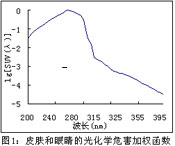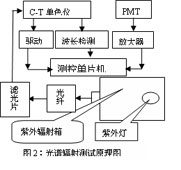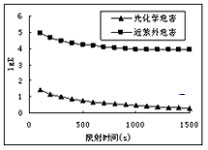Zhai Jiandong, Pei Tongsheng (State Key Laboratory of Modern Optical Instruments, Zhejiang University, Zhejiang University Tricolor Instrument Co., Ltd., Hangzhou, 310027) | ||||||||||||
Abstract : According to the requirements of photobiosafety in the new IEC and national standards, this paper discusses the safety evaluation methods of skin and eye photochemical hazards and near-ultraviolet hazards of ultraviolet light source in practical applications. A method for measuring ultraviolet effective radiation metrics based on ultraviolet spectral irradiance. Combining the actual two kinds of UV lamps, the conditions for the safe use of UV lamps are analyzed and discussed, which provides a practical and practical basis for people to safely use UV lamps. Measurement and evaluation of the safety of UV light sources Yu Jiandong, Mou Tongshen State Key Lab of Modern Optical Instrumentation of Zhejiang University, Abstract : Based on risk criteria and exposure limits of ultraviolet (UV) light source prescribed in the new IEC and Chinese National Standards, this paper describes something about evaluating hazards to human eyes and skin. Then it describes the way and principle about testing UV light Source. In the end, it shows and analyzes the results of testings, provides referrences for using UV light source safely. Key words: ultraviolet radiation(UVR), light safety, exposure limits I. Introduction    The electromagnetic spectrum from 100 nm to 400 nm is ultraviolet radiation (UVR). The ultraviolet radiation of the sun is the main body of ultraviolet radiation accepted by humans, but due to the attenuation process of ultraviolet light in the air, the amount of ultraviolet radiation actually irradiating the earth's surface accounts for only about 4% of the total radiation. But it is a very important physical factor in nature, and it is indispensable for various organisms to maintain normal metabolism. The International Commission on Illumination (CIE) divides the ultraviolet spectrum into three bands for discussing the biological effects of UVR: UV-A is 320-400 nm, UV-B is 280-320 nm, and UV-C is 100-280 nm. The wavelength below 180 nm is easily absorbed by the air, so it does not have much biological significance. Not only does the sun radiate ultraviolet light, but some artificial light sources such as ultraviolet lamps and arcs can also generate ultraviolet radiation. At present, the application of ultraviolet light is developing rapidly. For example, the application of photosensitive materials such as photographic paint or ink, photolithography, photolithography, photocopying, skin disease and internal surgical disease treatment, sterilization, health care, fluorescence analysis and other fields have developed rapidly. However, excessive UV radiation can also have a negative impact on human health. Therefore, human beings must protect against ultraviolet rays while developing and utilizing ultraviolet rays. The organs most susceptible to UVR radiation are the eyes and skin because they are completely exposed to the air, and from some examples of dental diseases it can be seen that the interior of the mouth may also be radiated. However, as long as we can control the ultraviolet radiation within an appropriate range, people can live and work normally under ultraviolet radiation without being harmed by such radiation. This is the purpose of studying the safety of light in the ultraviolet band. Second, the ultraviolet light source light safety requirements    1. Photochemical UV damage of skin and eyes Irradiation time within 8 hours (without considering more than 8 hours), the exposure limit of ultraviolet effective radiation incident on skin and eyes without protective measures is 30J·m -2. In order to protect the eye or skin from the ultraviolet radiation generated by the broad spectrum source, the effective integrated spectral irradiance Es of the source should not exceed the limits defined by the following equation.
2. The near-ultraviolet exposure of the eye has a range of exposure radiation ranging from 315 nm to 400 nm (UV-A). The total exposure of the eye to the eye will not exceed 10,000 J·m in the case of less than 1000 s. 2; In the case of time greater than 1000 s, the UV-A band irradiance EUVA for eyes without protection should not exceed 10 W·m-2.
(1), (2) where: Eλ (λ, t) - spectral irradiance, the unit is W · m - 2 · nm-1; SUV (λ) - photochemical ultraviolet hazard weighting function (Figure 1 Shown);
Third, the measurement principle Spectral Radiation Method: Measure the spectral radiant power of the light source at each wavelength, and integrate the spectral data of the corresponding band by computer or weight the integral of the bio-light receiving response function to obtain the irradiance (or radiant power) and photobioactivity of the specific band. The amount of radiation. The test principle is shown in Figure 2. Fourth, the safety analysis of the light source <br> In order to carry out safety analysis and evaluation of the ultraviolet light source, we tested two kinds of UV lamps. a) Photochemical hazards of skin and eyes b) near-ultraviolet hazard of the eye From equations (2a) and (2b): Note: In the above formulas (3) and (4), E in Fig. 4 represents the illuminance, and in the following 2 (5), (6) and in Fig. 6.
Figure 3: Spectral distribution of UV mercury lamps Figure 4: UV mercury safety evaluation curve The safety evaluation curve can be drawn by the above formula, as shown in Fig. 4 (since the illuminance values ​​of the two curves are relatively different, for the sake of clarity, the illuminance is in logarithmic form, as shown in Fig. 6), the figure shows: a) To avoid the above two types of UV hazards while irradiating the ultraviolet mercury lamp, the lamp must be operated in the common part of the area below the two curves in the figure (in Figure 4, the photochemical hazard evaluation curve and the irradiation time axis) Part of the area). b) The possibility of the near-ultraviolet hazard of the ultraviolet mercury lamp is much less than the possibility of photochemical hazards to the skin and eyes. The reason is that the spectral irradiance in the band of near-ultraviolet hazard of the eye is small in 315~400nm (Fig. 3). c) Example: In order to prevent ultraviolet hazard, when the human body is irradiated for 1000s, the illumination of the irradiated area of ​​the human body must be controlled to be less than 2.9061x, and the effective illuminance of 254nm for disinfection at this time can only be 5.954 uW/cm2. If we use the lamp at an illuminance of 10 lx, the time for the person to receive the irradiation is less than 290.68 s, and at this time the illuminating illuminance of the lamp with 254 nm is 20.48 uW/cm 2 . 2, UV health lights    UV health lights are used for beauty spotting, sunbathing, etc. Similarly, according to the principle of FIG. 2, the ultraviolet health light is placed in an ultraviolet radiation box to test the ultraviolet spectrum irradiance distribution. Test conditions: The distance between the light receiving head and the center of the light source is 1 m. The lamp current is 0.0823A, the lamp voltage is 219.8V, and the power is 18.1W. a) Photochemical hazards of skin and eyes b) near-ultraviolet hazard of the eye From equations (2a) and (2b):
Similarly, the safety evaluation curve can be made by the above formula, as shown in Fig. 6, which can be seen from the figure: a) To avoid both types of UV hazards while irradiating the UV lamp, the lamp must be used in the common part of the area below the two curves in the figure. b) Example: When the human body is exposed for 1000s, the illuminance of the illuminated area of ​​the human body must be controlled to be less than 35.317lx. If we use the lamp at an illuminance of 10 lx, the exposure time is less than 353.2 s. c) In combination with the provisions of the IEC standard for use in ultraviolet appliances, it is known:
V. Conclusion First, this paper combines the requirements of ultraviolet light safety to test and optical safety of two types of UV lamps, and obtains the expected purpose of providing practical basis for the safe use of these two types of UV lamps. Second, all kinds of ultraviolet light sources may cause harm to the human body, but as long as the effective radiation value of various types of hazards is controlled within a certain limit, various types of hazards can be avoided. Third, the main tasks of current research on optical safety are as follows: 1. Learn the advanced experience of countries in the leading position in light safety research, and find a safe light method suitable for China's national conditions, especially the photobiological characteristics of Chinese skin. 2. In line with international standards, accelerate the development of safety standards, and actively participate in the formulation of relevant documents on light biosafety by CIE and IEC. 3. Strengthen the research of various testing technologies and improve the equipment level and testing capability of quality inspection institutions. |
Wood Book Shelf Design,Atc Woodworking Machine,Desktop Cnc Router,Cnc Router
Syngood Machine Co., Ltd. , http://www.jnprintingmachine.com










